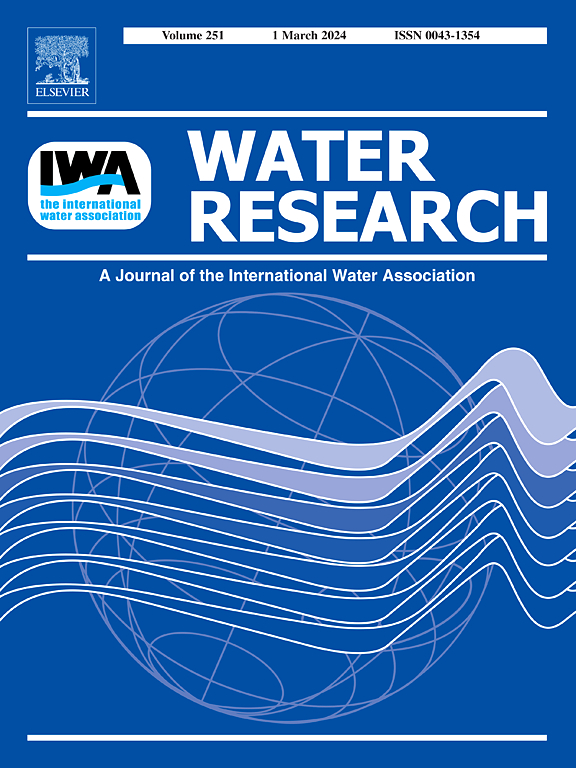在mbr中原位电催化硝酸盐-亚硝酸盐转化驱动厌氧氨氧化,用于极高效的含氨废水处理
IF 12.4
1区 环境科学与生态学
Q1 ENGINEERING, ENVIRONMENTAL
引用次数: 0
摘要
氮的去除对全球废水回收和再利用至关重要。厌氧氨氧化(anammox)是一项革命性的污水处理技术,提供可持续和经济高效的脱氮解决方案。然而,11%的硝酸盐(NO3−)作为副产物的产生仍然是一个关键的瓶颈,因为它限制了氮的去除效率,并且需要外部电子供体进行进一步的反硝化。为了克服这一限制,我们提出了一种创新的绿色电催化还原系统,其特点是铜网嵌入膜阴极,进入厌氧氨氧化生物过程。这种集成可以同时选择NO3−到NO2−(亚硝酸盐)转化和NO2−回收厌氧氨氧化反应。在浸没式膜生物反应器(MBR)中处理合成废水(总氮:2200-2400 mg/L),经过190天的运行,电催化改进的厌氧氨氧化系统的最大脱氮效率为94%,显著超过对照MBR(86%)。在低电流密度为0.1 mA/cm2的厌氧氨氧化操作环境中,NO3 -还原过程中NO2 -选择性(88.6%)显著高于铵态氮(5.9%),这促进了NO2 -的有效积累和重新引入厌氧氨氧化。从理论上讲,厌氧氨氧化和NO3−到NO2−转化的整合使N2产量达到总氮产品的99.6%,推进了厌氧氨氧化在主流废水处理中的应用,在主流废水处理中,实现部分硝化的稳定NO2−分流仍然是一个挑战。此外,耦合系统显示出明显延长的平均污染周期为31.4天,是对照组(15.7天)的两倍,这归因于电催化膜上的同步电- fenton氧化,同时降低了21%的能耗。显著减轻的膜污染增强了有价值的生长缓慢的厌氧氨氧化菌的保留,确保了持续高效的氮去除。这项工作通过厌氧氨氧化和电催化的协同作用,展示了一种极其高效和环保的废水处理范例,支持可持续的废水管理和碳中和目标。本文章由计算机程序翻译,如有差异,请以英文原文为准。


In situ electrocatalytic nitrate-to-nitrite conversion-driven anammox in MBRs for extremely efficient ammonium-containing wastewater treatment
Nitrogen removal is crucial for global wastewater recycling and reuse. Anaerobic ammonia oxidation (anammox) is a revolutionary wastewater treatment technology, offering sustainable and cost-effective nitrogen removal solutions. However, the generation of 11 % nitrate (NO3−) as a byproduct remains a critical bottleneck, as it limits nitrogen-removal efficiency and requires external electron donors for further denitrification. To overcome this limitation, we propose an innovative integration of a green electrocatalytic reduction system, featuring a copper mesh-embedded membrane cathode, into the anammox biological process. This integration enables simultaneous selective NO3−-to-NO2−(nitrite) conversion and NO2− recycling for anammox reactions. Over 190 days of operation in a submerged membrane bioreactor (MBR) treating synthetic wastewater (total nitrogen: 2200–2400 mg/L), the electrocatalytically improved anammox system achieved a maximum nitrogen-removal efficiency of 94 %, significantly surpassing the control MBR (86 %). This improvement was driven by considerably higher NO2− selectivity (88.6 %) over ammonium (5.9 %) during NO3− reduction at a low current density of 0.1 mA/cm2 in the anammox operational environment, which facilitated effective NO2− accumulation and reintroduction into anammox. Theoretically, the integration of anammox and NO3−-to-NO2− conversion enables N2 production to reach 99.6 % of total nitrogen products, advancing anammox application in mainstream wastewater treatment, where achieving a stable NO2− shunt from partial nitrification remains challenging. Furthermore, the coupled system exhibited a significantly prolonged average fouling cycle of 31.4 days—twice that of the control (15.7 days)—attributed to synchronous electro-Fenton oxidation on the electrocatalytic membrane, while simultaneously reducing energy consumption by 21 %. The significantly mitigated membrane fouling enhanced the retention of valuable slow-growing anammox bacteria, ensuring sustained high-efficiency nitrogen removal. This work demonstrates an extremely efficient and environmentally friendly wastewater treatment paradigm through the synergy between anammox and electrocatalysis, supporting sustainable wastewater management and carbon neutrality goals.
求助全文
通过发布文献求助,成功后即可免费获取论文全文。
去求助
来源期刊

Water Research
环境科学-工程:环境
CiteScore
20.80
自引率
9.40%
发文量
1307
审稿时长
38 days
期刊介绍:
Water Research, along with its open access companion journal Water Research X, serves as a platform for publishing original research papers covering various aspects of the science and technology related to the anthropogenic water cycle, water quality, and its management worldwide. The audience targeted by the journal comprises biologists, chemical engineers, chemists, civil engineers, environmental engineers, limnologists, and microbiologists. The scope of the journal include:
•Treatment processes for water and wastewaters (municipal, agricultural, industrial, and on-site treatment), including resource recovery and residuals management;
•Urban hydrology including sewer systems, stormwater management, and green infrastructure;
•Drinking water treatment and distribution;
•Potable and non-potable water reuse;
•Sanitation, public health, and risk assessment;
•Anaerobic digestion, solid and hazardous waste management, including source characterization and the effects and control of leachates and gaseous emissions;
•Contaminants (chemical, microbial, anthropogenic particles such as nanoparticles or microplastics) and related water quality sensing, monitoring, fate, and assessment;
•Anthropogenic impacts on inland, tidal, coastal and urban waters, focusing on surface and ground waters, and point and non-point sources of pollution;
•Environmental restoration, linked to surface water, groundwater and groundwater remediation;
•Analysis of the interfaces between sediments and water, and between water and atmosphere, focusing specifically on anthropogenic impacts;
•Mathematical modelling, systems analysis, machine learning, and beneficial use of big data related to the anthropogenic water cycle;
•Socio-economic, policy, and regulations studies.
 求助内容:
求助内容: 应助结果提醒方式:
应助结果提醒方式:


